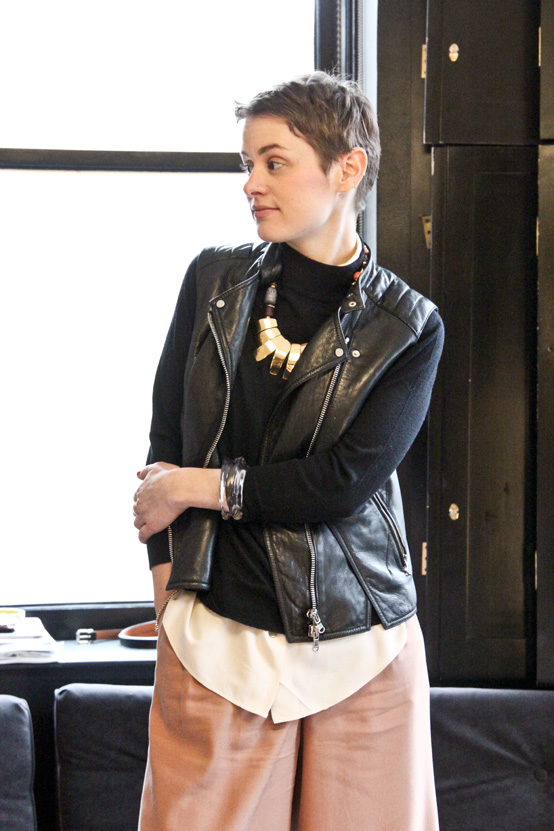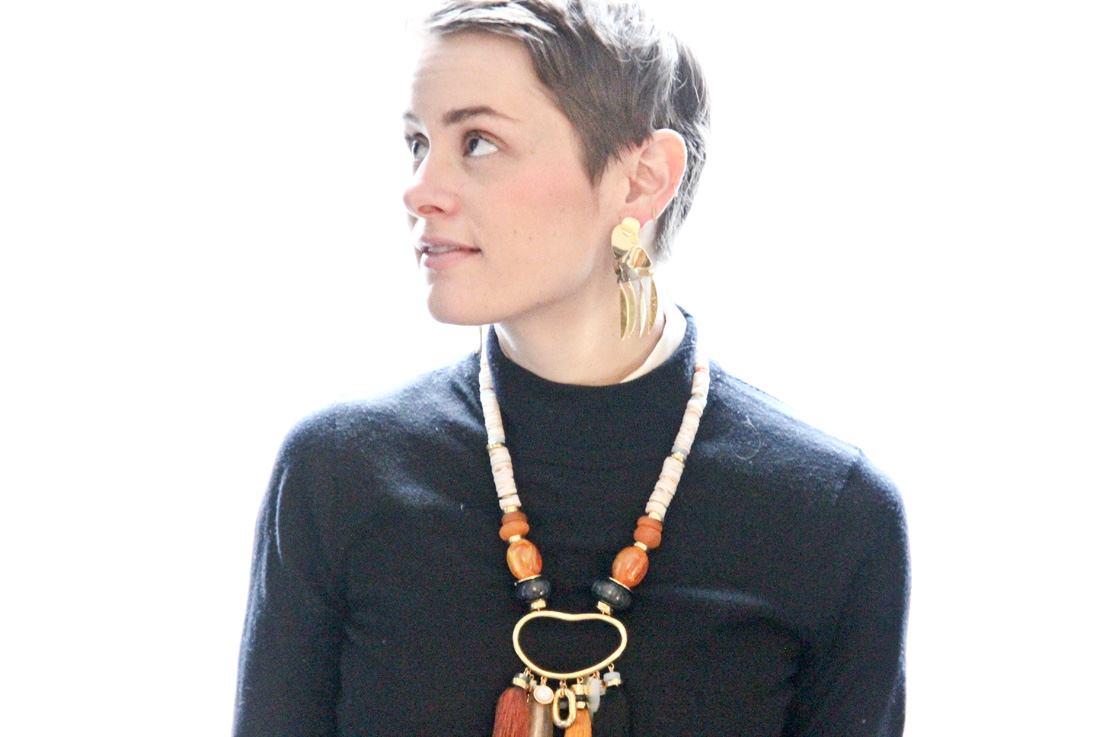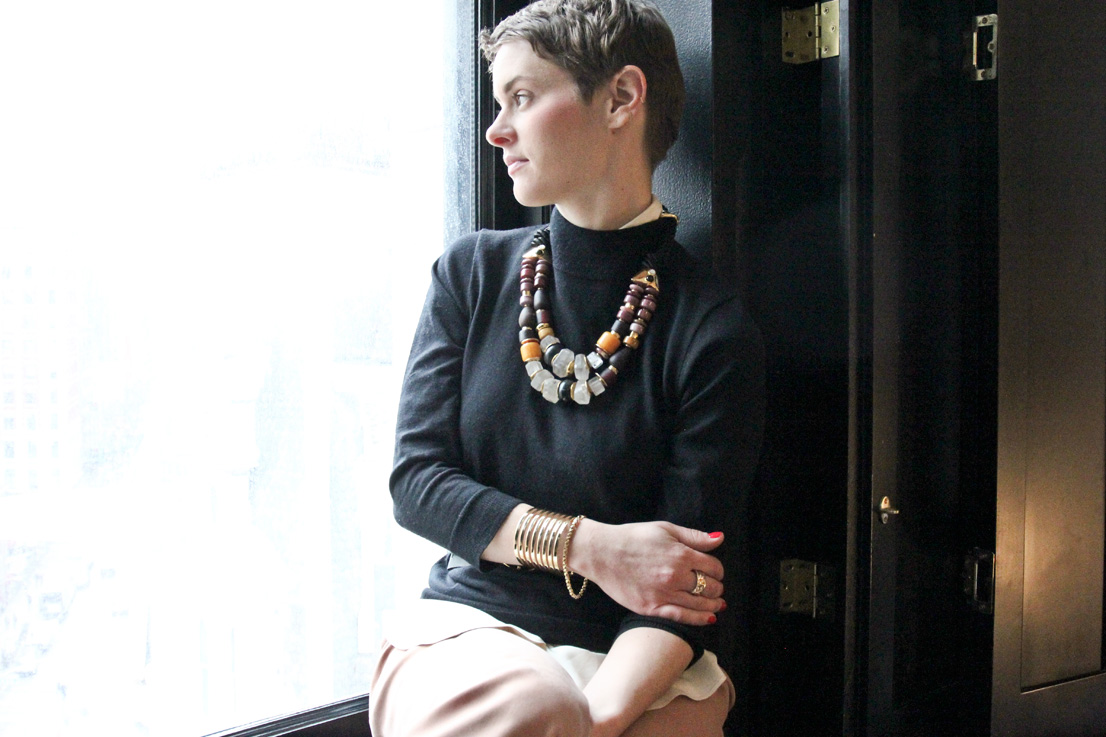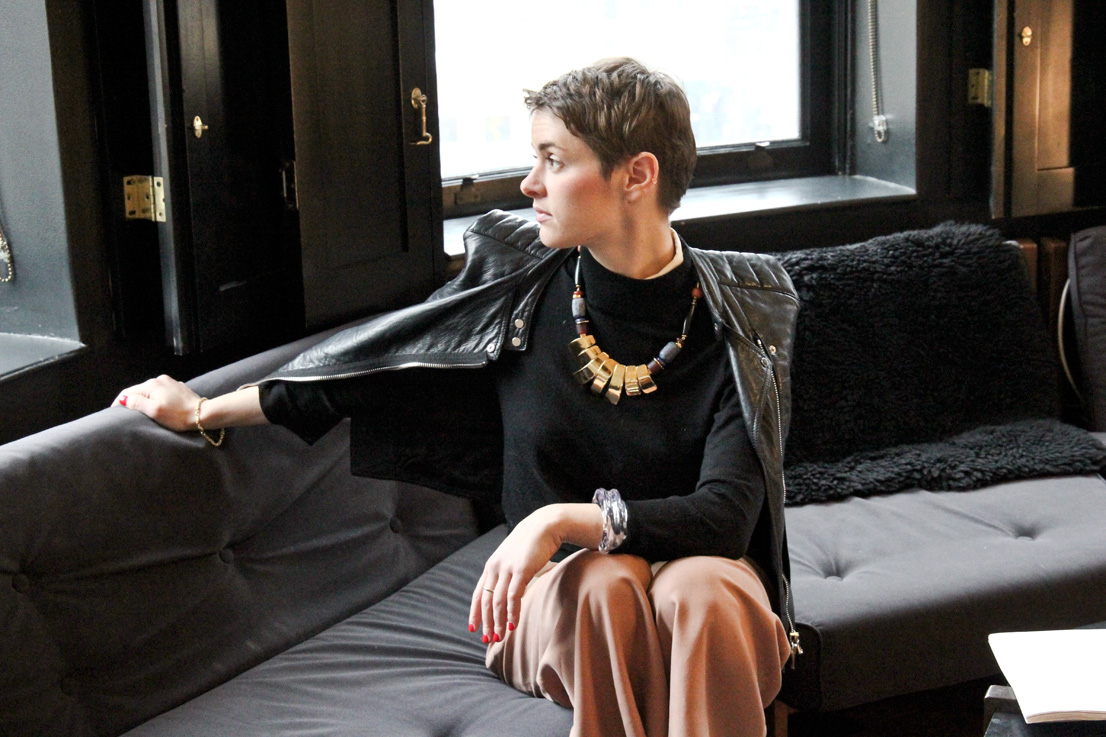Some people are so destined to do their jobs, it was written in the stars from childhood. Case in point: Lizzie Fortunato, designer and force behind her eponymous jewellery line, who, started designing clothes for herself and friends her early teens. Not only did she quickly hone in on her design skills, from the beginning she realised that her knack with clothes could turn into something much bigger.
How does one pay for a Spring Break trip? You launch a business out of your dorm room, obviously. That’s how she funded her trips to Paris in between her term time commitments. By turning her room into a mini factory where she could hand craft unique pieces of jewellery, Lizzie, alongside her entrepreneurial twin sister Kathryn, ran trunk shows where they sold enough of her designs to ensure they could get themselves to Europe and back. Thanks to Kathryn’s business mind and Lizzie’s handicraft designs, they built up the kind of loyal customer base of friends and fellow students to rival the big guns.
Less than a year out of college, that same customer base is exactly what gave her the confidence to quit the security of her 9-to-5 job in PR to go out on her own. Taking a lifelong passion for statement jewellery and handicrafts, the Fortunato sisters have built an accessories brand with a distinct identity rooted in this love of homemade items worth cherishing. The pair have gone on to launch a brand that not only sells Lizzie’s unique jewellery, but has branched out into beaded clutches, timeless leather totes and even Fortune Finds, the carefully curated shop selling items they have picked up on their travels.
Here Lizzie talks style, the power of the right accessories and everything you need to know about embracing change and turning your hobby into a business. Prepare to take notes.
 I have been interested in design ever since I was a kid. I was also hand-sewing scraps of fabric together (I can remember making my mom a pillow out of one of my jeans – I don’t know how enthused she was!) and in the 6th grade I asked her to sign me up for sewing classes. I loved the idea of being able to create something with my own hands that would transform the way I looked. I remember having really distinct and strong opinions about fashion as a kid. In the fourth grade my favourite outfit (and one that I wore often to school) was bright yellow jeans and a white poets blouse. I probably looked ridiculous but I just remember feeling so passionate about that look. I remember hand-making (and even lining!) a pair of polka dot pants as a 13 or 14 year old too. All of the pieces were so specific, and certainly not trending, but looks that I loved. For me fashion and style are such a form of self-expression.
I have been interested in design ever since I was a kid. I was also hand-sewing scraps of fabric together (I can remember making my mom a pillow out of one of my jeans – I don’t know how enthused she was!) and in the 6th grade I asked her to sign me up for sewing classes. I loved the idea of being able to create something with my own hands that would transform the way I looked. I remember having really distinct and strong opinions about fashion as a kid. In the fourth grade my favourite outfit (and one that I wore often to school) was bright yellow jeans and a white poets blouse. I probably looked ridiculous but I just remember feeling so passionate about that look. I remember hand-making (and even lining!) a pair of polka dot pants as a 13 or 14 year old too. All of the pieces were so specific, and certainly not trending, but looks that I loved. For me fashion and style are such a form of self-expression.
In high school I made my prom dress and I’m proud that it’s still something I would wear today (if only I could fit in it!): a lavender grey raw silk dress with a V-neck and open back. I started playing around with jewellery just before I left for college, because I thought it would be easier and faster to make than clothing (little did I know!). When I got to college I discovered a local bead store and turned my dorm room into a little factory – putting together all sorts of pieces between classes and into the wee hours of the night. By sophomore year of college, my entrepreneurial-minded twin sister (and business partner) Kathryn was hosting semi-annual trunk shows to showcase my work on campus. These funded spring break trips to Paris and kept me busy throughout the semester as I filled orders.
After graduation, I did a short stint in fashion PR but I was really encouraged by the girls who had supported the line in college and continually asked for new pieces to go for it. After less than a year I quit my job and decided to pursue the line full time. I was lucky to have built a foundation and early customer base during my college years and the early days of the business were quite organic. We never raised money, instead I pounded the pavement and picked up a few boutiques around New York City – designing, producing, and selling the product myself. Once we had a few accounts, everything got easier and word began to spread and now 8 years later here we are selling internationally and working with top tier editors and retailers all through slow, steady, organic growth. Venturing into new territories can be daunting, but getting stuck in old ones is even scarier. I think change is healthy and good I’m more scared of feeling static.
[show_shopthepost_widget id=”1559967″]
When it comes to working on new collections, I draw inspiration from all over the place – fine art, architecture, a photograph, and most often from travel. I find that if I have just visited somewhere that is foreign and new then it’s really easy to design the collection. For example, spring ’14 was inspired by time I spent in Japan and fall ’15 was based on my travels in Morocco. Both of these collections came to me pretty easily because I had so many beautiful (and new) references to draw from. Once I have the basis of a collection (be it a place or an artist) I collect images and references and put together a mood board. From there I’ll source materials that seem relevant (we get materials from different vendors from African bead dealers, to semi-precious stone cutters, to fabric and leather houses) and will create new castings. This process takes a while because our line uses such a huge array of different materials. In any given collection there might be ten different semi-precious stones used along with hundreds of different types of beads, chains, leathers, and castings. Once I have all my materials I really let them dictate the process. I will lay styles out and put them together and take them apart until I love the way they look and lay – it’s very important to me that the jewellery is comfortable and easy to wear. From there we price and photograph the pieces and present them at market week. We work on a ready-to-wear calendar, so buyers will place their orders at the same time they are buying ready to wear (in line with the traditional fashion week schedule) and then we produce the pieces by hand and deliver them about 3 months later. The best part is the a-ha moment when I have about 10-12 styles designed and I have a vision of the collection coming together. I love that day when I come into the office and I see an assortment starting to form that really makes sense and looks beautiful together; once I get over that hump the rest is easy and by the day of the look book shoot I’m practically jumping for joy!
Every time in the past that I’ve tried to tailor my work towards a trend or towards what others are doing it falls flat or doesn’t sell as well as when I just focus on designs that I feel really good about or that come naturally to me.
I think that instinct cannot be under estimated when it comes to design. We’ve occasionally designed into a buyer’s specific request (sometimes they will customize a piece according to a trend or need in the market) and this really doesn’t work unless I really believe in the design. Our sales are not as strong when I am designing according to a trend or a particular request and it’s such a telling reminder to make what I love and “feel” because otherwise it tends to miss the mark. For me, it’s important to make sure that every season introduces something new while also feeling like an evolution rather than a revolution. As we know, the accessories market is saturated and it’s easy to become irrelevant if you don’t evolve. With that said, it’s important not to completely depart from your hallmarks or else it looks like you’re just chasing trends. We’ve developed a very loyal following and once our customer has purchased a certain style from they tend to want something new the following season, but the line maintains it’s governing principles – mixed mediums, pops of colours and unique silhouettes – so we find that people always recognize the aesthetic even if we don’t have core styles that we repeat season in and season out. It can definitely be challenging not to get distracted by trends and what other designers are doing, but I think history provides the lesson here. Every time in the past that I’ve tried to tailor my work towards a trend or towards what others are doing it falls flat or doesn’t sell as well as when I just focus on designs that I feel really good about or that come naturally to me. When there’s a piece that I really put my heart and soul into and that feels uniquely “Lizzie”, buyers tend to be able to tell and those styles excel. I try and remember that and I also try and limit blog and Pinterest time when I’m designing, as hard as that can be.
Fortune Finds started as a passion project but has developed into an interesting part of our business. I was traveling so much for inspiration and sourcing and work, and continually bringing back textiles and ceramics and handicrafts from the places I visited. These items were piling up in my teeny SoHo apartment to the point where I no longer had room for them. Simultaneously our friends were complimenting these wares, and always asking for us to shop for them when we travelled. We thought, if our immediate friends and family have interest in the items we source then other people probably will too. So now we sell finds from our travels and curated art and products from third party artists that we admire direct to consumer via our website. It’s a small part of our business, but one that I feel really strongly about. All of the Fortune Finds that we stock are things I 100% believe in, and things that I would (and often do) have in my own home. I love being able to champion the handiwork and artistic pursuits of other independent designers through this channel.
[show_shopthepost_widget id=”1560000″]
We started offering handbags because we were using seed beading in some of our necklace designs and kept thinking that it would nice to have a way of showcasing the intricacy in a bigger scale. This sparked the idea of a clutch and the rest is history. We began exploring all different embroidery and weaving techniques and now we have an extensive assortment of clutches and purses that feature all of this beautiful handiwork. We’re launching belts for fall ’16, which I am incredibly excited about. I initially designed the rope tassels styles and leather waist belts just to style in the look book, but then everyone in the office liked them so much that we decided to offer them for sale. The response was tremendous and we are so excited that you’ll be able to buy them in the coming season. I think expansion into different realms of the accessories (and home accessories) world will be the next steps for us.
 I try and keep up to speed with the industry by reading Business of Fashion and talking to other designers. It may sound like work, but a great evening for me is a night out with other NYC-based jewellery or apparel designers who are facing the same hurdles (and victories) as we are. It’s wonderful to have a community of peers to bounce ideas off of. Equally important is stepping out of the industry periodically. My boyfriend and I escape upstate every time I wrap a collection and try and travel as much as possible. Getting out of the NYC chaos and into different landscapes puts things in perspective and is a necessary reprieve from the non-stop fashion world.
I try and keep up to speed with the industry by reading Business of Fashion and talking to other designers. It may sound like work, but a great evening for me is a night out with other NYC-based jewellery or apparel designers who are facing the same hurdles (and victories) as we are. It’s wonderful to have a community of peers to bounce ideas off of. Equally important is stepping out of the industry periodically. My boyfriend and I escape upstate every time I wrap a collection and try and travel as much as possible. Getting out of the NYC chaos and into different landscapes puts things in perspective and is a necessary reprieve from the non-stop fashion world.
A typical week for me now involves a lot of breakfast meetings; I really prefer these to lunch or after work meetings because escaping the office in the middle of the day is near impossible and I’m trying (not entirely successfully) to spend more time at home in the evenings. So I’ll do an early breakfast meeting around 8 or 8:30 with a retailer or editor a few days a week and then I’m in the office working on new designs, overseeing production (we do nearly all of our production here in NYC so there is a lot of hands on attention), and advising on different projects that we have going on. No two days are the same because we have so many things happening at once and I’m running in so many different directions. I tend to do the bulk of my sampling right (before we photograph & present a collection) late at night when the office is empty because I have to get in a zone to make it all come together.
My every day style is basic neutral pieces: boyfriend blazers, straight leg jeans (always hemmed because I’m short!), Chelsea boots and black cashmere turtleneck sweaters dressed up with pops of colour and good accessories. I don’t do trends because I know what works for me. Most days in the office you can find me in black jeans, a sweater or a blazer. And for dress up it’s high waisted pleated pants or high-waisted skirts. I live in Clinton Hill Brooklyn, work in the Lower East Side of Manhattan and am usually out in SoHo or The West Village for dinner so I never have time to go home in between the running around so need to wear clothes and jewellery that doesn’t get in the way. I usually put heels in my bag and will wear neutral-toned pants and a top that can be dressed up by slipping on a pair of heels and a big necklace or earring. Even when I’m dressing up, I hate clothes that feel cumbersome. I like things I can run around in!
Thinking about it, my style hasn’t really changed too much over the years; I still wear pieces I bought years ago. I used to buy more because I would worry that I needed a new outfit for every party or event, but now I try and invest in fewer (but nicer) pieces. I like to purchase pieces that feel authentic; not like they just came out of a factory in China. I love supporting young designers who produce locally or who can relay the story of how their pieces are produced. There has been such a trend in knowing where our food comes from, and I love the idea of this following suit in fashion. I think people are becoming more interested in knowing where their clothes come from and knowing that they’re buying something that is produced with values they believe in.
This interview has been edited and condensed. Lizzie was shot in The Ace Hotel New York.



